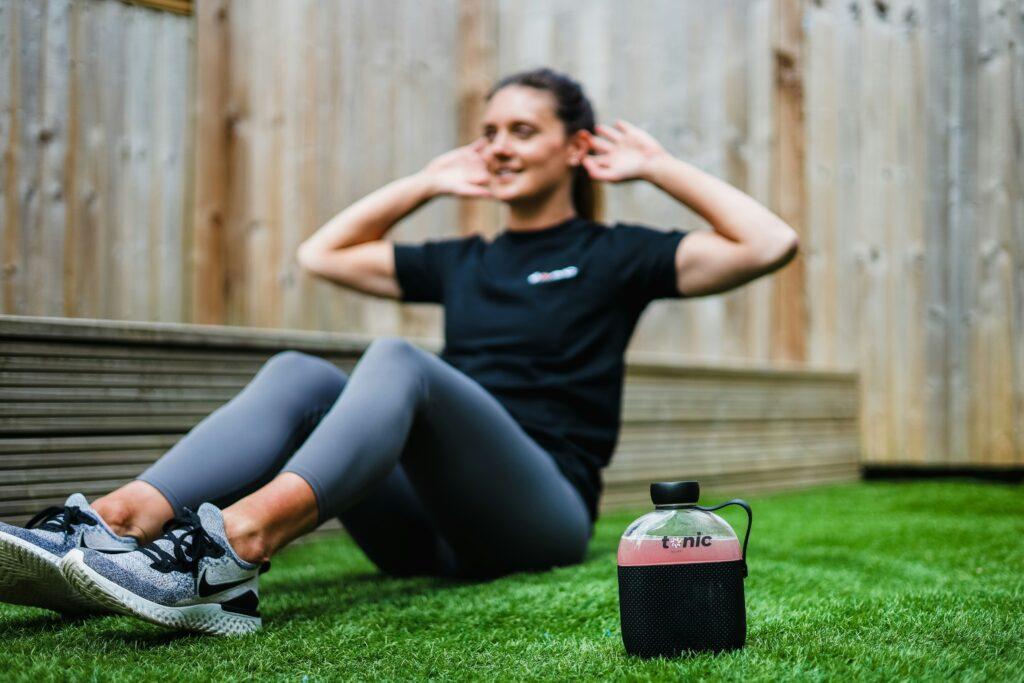When it comes to building a strong core and preventing injuries, traditional ab exercises like crunches and sit-ups may not be the most effective option. Functional core training, which focuses on training the entire core, is the key to developing real core strength and stability, these are safe ab exercises. This type of training targets muscles beyond just the rectus abdominis, including the transverse abdominis, external obliques, internal obliques, and more. By engaging the entire core, you can improve posture, protect your internal organs, and enhance your overall health and quality of life.
Key Takeaways:
- Functional core training is essential for building core strength and stability.
- Traditional ab exercises like crunches and sit-ups may not be as effective.
- Engaging the entire core targets different muscles for better overall results.
- Improved posture, organ protection, and overall health are benefits of functional core training.
- Train your core effectively and safely to avoid injury and optimize results.
The Anatomy of the Core
To understand the importance of core training, it’s essential to know the anatomy of the core. The core is composed of various muscles that work together to provide stability, protect the spine, and enable rotation and flexion of the trunk. These muscles include:
- Abdominal muscles: The rectus abdominis, commonly known as the “six-pack” muscles, helps with posture, breathing, and spinal support.
- Transverse abdominis: This deep core muscle wraps around the abdomen, providing stability and protection to the spine.
- External obliques: These muscles run diagonally along the sides of the abdomen, allowing for rotation and lateral flexion of the trunk.
- Internal obliques: Situated beneath the external obliques, these muscles also enable trunk rotation and flexion.
Training these core muscles through core exercises is crucial for overall core strength and stability. By targeting each of these muscle groups, you can develop a strong and functional core that supports your daily activities and physical performance.
“Understanding the anatomy of the core is the foundation for effective core training.”
The Benefits of Functional Core Training
Functional core training offers numerous benefits beyond just aesthetic improvements. Research shows that core stability plays a significant role in preventing lower extremity injuries, such as ACL injuries. It also improves proprioception, balance, and muscle activation. By engaging in functional core training, you can enhance core strength, stability, and overall physical performance while reducing the risk of injury.
“The importance of core stability in injury prevention cannot be understated. By strengthening the core, you create a solid foundation for your entire body, improving your ability to move efficiently and reducing the likelihood of injury.”
One of the key advantages of functional core training is its ability to activate deep stabilizing muscles that are often neglected in traditional ab exercises. These deep stabilizers help to maintain proper alignment and protect your spine during movement and everyday activities.
 In addition to injury prevention, functional core training also enhances balance and proprioception. Balance is critical for performing everyday tasks, such as walking or standing on one leg. Proprioception, on the other hand, refers to your body’s ability to sense its position and movement in space. By training your core, you improve both balance and proprioception, leading to increased stability in all areas of your life.
In addition to injury prevention, functional core training also enhances balance and proprioception. Balance is critical for performing everyday tasks, such as walking or standing on one leg. Proprioception, on the other hand, refers to your body’s ability to sense its position and movement in space. By training your core, you improve both balance and proprioception, leading to increased stability in all areas of your life.
The benefits of functional core training extend beyond physical performance. Studies have shown that individuals with greater core strength and stability experience improvements in posture and reduced back pain. Developing a strong core can also enhance athletic performance in various sports such as running, cycling, and weightlifting.
To maximize the benefits of functional core training, it’s essential to focus on exercises that engage multiple muscle groups simultaneously. These compound exercises not only strengthen the core but also improve overall functional strength and coordination.
Sample Exercise: Russian Twist
One effective exercise for engaging the core and improving rotational stability is the Russian twist. Here’s how to perform it:
- Start by sitting on the floor with your knees bent and your feet flat on the ground.
- Lean back slightly, engaging your core muscles.
- Extend your arms straight out in front of you, clasping your hands together.
- Slowly twist your torso to one side, bringing your hands towards the floor beside your hip.
- Pause briefly, then twist to the other side.
- Repeat this movement for the desired number of reps.
Remember to keep your core engaged throughout the exercise and maintain a controlled, slow movement. As with any exercise, it’s important to start with a weight or resistance level that is appropriate for your fitness level and gradually increase as you get stronger.
A complete functional core training routine may include a variety of exercises that target different muscle groups within the core. This ensures that you are training your core comprehensively and not just focusing on one area.
| Exercise | Main Muscles Targeted |
|---|---|
| Plank | Transverse abdominis, rectus abdominis, erector spinae |
| Bird Dog | Transverse abdominis, erector spinae, glutes |
| Dead Bug | Transverse abdominis, rectus abdominis, hip flexors |
| Mountain Climbers | Transverse abdominis, rectus abdominis, hip flexors, shoulders |
| Side Plank | Transverse abdominis, obliques |
By incorporating these exercises into your workout routine and focusing on functional core training, you can reap the benefits of improved core strength, injury prevention, muscle activation, balance, and proprioception.
Safe Ab Exercises for Building Core Strength
When it comes to building core strength, there are several effective ab exercises that you can incorporate into your workout routine. These exercises target different muscle groups in your core and provide a challenging and effective way to strengthen your abdominal muscles.
Hollow Hold and Hollow Rock
The hollow hold and hollow rock exercises are great for activating the transverse abdominis, which is the deepest layer of your abdominal muscles. These exercises also challenge your balance and control, helping to improve your overall core stability. To perform the hollow hold, lie on your back with your arms straight above your head and your legs lifted off the ground, keeping your lower back pressed into the floor. Hold this position for a designated time. The hollow rock is performed by rocking back and forth while maintaining the hollow hold position. Aim for controlled movements and a steady rhythm.
Tuck-Ups, V-Ups, and L-Sits
Tuck-ups, V-ups, and L-sits are advanced ab exercises that target your abdominal muscles, glutes, and hip flexors. These exercises require a high level of core strength and control. To perform a tuck-up, lie on your back with your arms extended overhead. Lift your upper body and legs simultaneously, bringing your knees toward your chest. V-ups involve reaching your arms and legs up off the ground, simultaneously lifting them to create a V shape. L-sits challenge your core by lifting your entire body off the ground, keeping your legs extended in front of you.
Plank Variations
Plank variations are excellent for enhancing core stiffness and engaging multiple muscle groups in your core. The forearm plank and side plank are two effective options. To perform the forearm plank, start by resting on your forearms and toes, with your body in a straight line. Engage your core and hold this position for a designated time. The side plank targets the oblique muscles. Start by lying on your side, then lift your body up onto your forearm and outer edge of your foot. Keep your body in a straight line and hold the position for a designated time.
Bird Dogs, Dead Bugs, and Supermans
Bird dogs, dead bugs, and supermans are exercises that focus on core stability and alignment. The bird dog exercise involves getting on all fours and extending one arm forward while simultaneously extending the opposite leg backward. Alternate sides and maintain a stable core throughout. Dead bugs require lying on your back with your arms extended toward the ceiling and your legs raised with your knees bent at a 90-degree angle. Lower one leg and the opposite arm simultaneously while maintaining core stability. Supermans are performed by lying on your stomach with your arms extended in front of you. Lift your legs and arms off the ground simultaneously, engaging your lower back muscles.
Remember, it’s important to perform these ab exercises with proper form to ensure effectiveness and prevent injuries. Start with exercises that match your current fitness level, and gradually increase intensity as your core strength improves. It’s always a good idea to consult with a fitness professional to ensure you’re performing the exercises correctly and to get personalized guidance.
Now let’s take a look at an example workout routine that combines these effective ab exercises to help you build core strength:
| Exercise | Reps | Sets |
|---|---|---|
| Hollow Hold | 20 seconds | 3 |
| Tuck-Ups | 10 | 3 |
| Forearm Plank | 30 seconds | 3 |
| Bird Dogs | 10 reps each side | 3 |
Customizable Workouts for All Fitness Levels
When it comes to building core strength, it’s essential to tailor your workouts to your fitness level. Gradually progressing with targeted exercises can help you develop a strong core while minimizing the risk of injury. Whether you’re a beginner, intermediate, or advanced, there are customizable workout routines suitable for everyone.
Beginner Circuit
If you’re new to core training, a beginner circuit is an excellent starting point. This circuit focuses on fundamental exercises that establish a solid foundation for core strength.
- Dead Bug: Lie on your back with your arms extended toward the ceiling and your knees bent at a 90-degree angle. Slowly extend one leg while simultaneously lowering the opposite arm toward the floor. Return to the starting position and repeat on the other side.
- Plank: Begin in a push-up position with your forearms resting on the ground. Engage your core and maintain a straight line from your head to your heels. Hold this position for as long as you can while maintaining proper form.
- Side Plank: Start by lying on your side with your forearm on the ground and your feet stacked on top of each other. Lift your hips off the floor, creating a straight line from your head to your feet. Hold this position, then switch sides.
Intermediate Circuit
If you’ve been consistently working on your core strength and want to challenge yourself further, an intermediate circuit is the next step. This circuit introduces more dynamic exercises to engage your core muscles.
- V Bicycle: Lie on your back with your legs extended and your hands placed lightly behind your head. Engage your core as you lift your upper body off the ground, bringing your left elbow towards your right knee. Repeat on the other side, creating a bicycle-pedaling motion.
- Elbow Plank Pass-Through: Start in an elbow plank position. Lift your right arm and reach it underneath your body, passing it between your left forearm and the floor. Return to the starting position and repeat with your left arm.
- Side Plank Knee to Elbow: Begin in a side plank position with your left forearm resting on the ground. Bring your right knee towards your right elbow, engaging your oblique muscles. Return to the starting position and repeat on the other side.
Advanced Circuit
If you’re looking for a challenge and want to push your core strength to the next level, the advanced circuit is designed for you. This circuit incorporates dynamic movements that engage multiple muscle groups simultaneously.
- Hip Touches: Assume a high plank position with your wrists directly under your shoulders. Keeping your hips level, tap your left hip with your right hand, then tap your right hip with your left hand. Alternate sides, maintaining a strong and stable core.
- Squat Thrusts: Begin in a standing position with your feet shoulder-width apart. Squat down and place your hands on the ground. Jump your feet back into a high plank position, then jump them back to your hands and stand up explosively.
- Lateral High Knees: Stand with your feet hip-width apart. Quickly lift your right knee towards your right elbow while simultaneously twisting your left shoulder towards your right knee. Repeat on the other side, alternating between left and right.
Remember, it’s essential to modify exercises if needed to prevent injuries. If you’re unsure about proper form or which exercises are suitable for your fitness level, consult with a fitness professional for personalized guidance. By gradually progressing through these customizable workouts, you can build core strength effectively and safely.
The Importance of Proper Form and Core Engagement
When performing ab exercises, it’s crucial to prioritize proper form and engage your core muscles correctly. By doing so, you can maximize the effectiveness of your workouts and minimize the risk of injury. One key aspect of maintaining proper form is avoiding neck strain. It’s important to keep your neck aligned with your spine throughout the exercises to prevent unnecessary tension and strain.
Another vital element of ab exercises is core engagement. The core is not only the rectus abdominis, but also includes other muscles such as the transverse abdominis, external obliques, and internal obliques. By consciously engaging your entire core during ab exercises, you can enhance stability, improve your overall posture, and prevent imbalances in muscle activation.
If you have diastasis recti, a condition characterized by the separation of the abdominal muscles, it’s even more crucial to be mindful of proper form and core engagement. Diastasis recti can weaken the core muscles and affect the overall integrity of the abdominal wall. Consulting with a fitness professional can provide you with expert guidance on how to modify exercises and engage your core effectively while considering your specific needs.
Low-Impact Ab Exercises for Injury Prevention
If you have injuries or prefer low-impact options, there are several modified ab exercises that can help you strengthen your core effectively and safely. These exercises are gentle on your body while still providing the benefits of core training. By incorporating low-impact exercises into your fitness routine, you can prioritize injury prevention and maintain your overall health.
Bridges
Targeted Muscles: Glutes, Hamstrings, Core
Bridge exercises are an excellent low-impact option for engaging your core without putting excessive strain on your body. Lie on your back with your knees bent and feet flat on the floor. Lift your hips off the ground, creating a straight line from your knees to shoulders. Hold this position for a few seconds, then lower your hips back to the ground. Repeat for the desired number of repetitions.
Gentle Twists
Targeted Muscles: Obliques, Core
Gentle twists are a modified version of traditional oblique exercises that provide a low-impact alternative. Begin in a seated position with your knees bent and feet on the ground. Place your hands behind your head and engage your core. Slowly rotate your torso to one side, bringing your elbow toward the opposite knee. Return to the starting position and repeat on the other side. Perform this exercise with controlled movements to avoid straining your muscles.
Modified Planks
Targeted Muscles: Core, Shoulders, Arms
Planks are renowned for their effectiveness in targeting the core muscles. For a low-impact variation, perform a modified plank by starting on your knees instead of your toes. Place your forearms on the ground, elbows directly below your shoulders, and engage your core. Maintain a straight line from your knees to your head. Hold this position for the desired amount of time, focusing on maintaining proper form and engaging your core throughout the exercise.
Remember, when exercising with injuries or choosing low-impact options, it’s essential to listen to your body and make appropriate modifications based on your individual needs and limitations. Always prioritize injury prevention and consult with a fitness professional if you have any concerns or specific conditions. By incorporating these low-impact exercises into your fitness routine, you can continue strengthening your core while minimizing the risk of further injury.
Conclusion
Building core strength and preventing injuries should be a top priority when it comes to your fitness routine. By incorporating functional core training and performing effective ab exercises with proper form, you can achieve optimal results.
When focusing on core strength, it’s important to target the entire core, including the rectus abdominis, transverse abdominis, external obliques, and internal obliques. Engaging these muscles through a variety of exercises not only improves your physical performance but also enhances your overall health and quality of life.
Regardless of your fitness level, it’s crucial to consider modifications and consult with a fitness professional for personalized guidance. They can help you choose the right exercises, customize workout routines, and ensure that you maintain proper form throughout your training.
Remember, developing a strong core isn’t just about aesthetics. It plays a key role in injury prevention, stability, and functional movement. So, prioritize your core strength, practice effective ab exercises, focus on proper form, and reap the benefits of a healthier and more resilient body.








